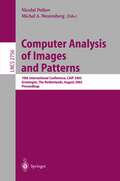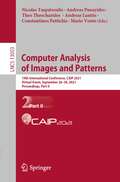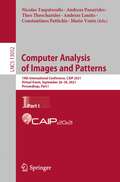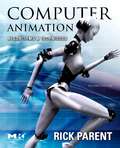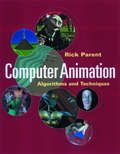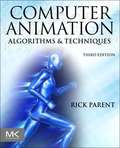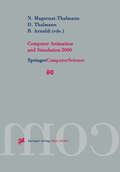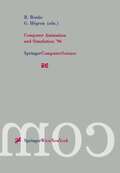- Table View
- List View
Computer Analysis of Images and Patterns: 10th International Conference, CAIP 2003, Groningen, The Netherlands, August 25-27, 2003, Proceedings (Lecture Notes in Computer Science #2756)
by Nicolai Petkov Michel A. WestenbergThis volume presents the proceedings of the 10th International Conference on Computer Analysis of Images and Patterns (CAIP 2003). This conference - ries started about 18 years ago in Berlin. Initially, the conference served as a forum for meetings between scientists from Western- and Eastern-bloc co- tries. Nowadays, the conference attracts participants from all over the world. The conference gives equal weight to posters and oral presentations, and the selected presentation mode is based on the most appropriate communication medium. The programme follows a single-track format, rather than parallel s- sions. Non-overlapping oral and poster sessions ensure that all attendees have the opportunity to interact personally with presenters. As for the numbers, we received a total of 160 submissions. All papers were reviewed by two to three members of the Programme Committee. The ?nal - lection was carried out by the Conference Chairs. Out of the 160 papers, 42 were selected for oral presentation and 52 as posters. At this point, we wish to thank the Programme Committee and additional referees for their timely and high-quality reviews. The paper submission and review procedure was carried out electronically. We thank Marcin Morg´ os from Scalar–IT Solutions for p- viding us with the Web-based participant registration system. We also thank the invited speakers Nicholas Ayache, John Daugman, and Dariu Gavrila, for kindly accepting our invitation.
Computer Analysis of Images and Patterns: 9th International Conference, CAIP 2001 Warsaw, Poland, September 5-7, 2001 Proceedings (Lecture Notes in Computer Science #2124)
by Wladyslaw SkarbekComputer analysis of images and patterns is a scienti c eld of longstanding tradition, with roots in the early years of the computer era when electronic brains inspired scientists. Moreover, the design of vision machines is a part of humanity’s dream of the arti cial person. I remember the 2nd CAIP, held in Wismar in 1987. Lectures were read in German, English and Russian, and proceedings were also only partially written in English. The conference took place under a di erent political system and proved that ideas are independent of political walls. A few years later the Berlin Wall collapsed, and Professors Sommer and Klette proposed a new formula for the CAIP: let it be held in Central and Eastern Europe every second year. There was a sense of solidarity with scienti c communities in those countries that found themselves in a state of transition to a new economy. A well-implemented idea resulted in a chain of successful events in Dresden (1991), Budapest (1993), Prague (1995), Kiel (1997), and Ljubljana (1999). This year the conference was welcomed at Warsaw. There are three invited lectures and about 90 contributions written by more than 200 authors from 27 countries. Besides Poland (60 authors), the largest representation comes from France (23), followed by England (16), Czech Republic (11), Spain (10), G- many (9), and Belarus (9). Regrettably, in spite of free registration fees and free accommodation for authors from former Soviet Union countries, we received only one accepted paper from Russia.
Computer Analysis of Images and Patterns: 8th International Conference, CAIP'99 Ljubljana, Slovenia, September 1-3, 1999 Proceedings (Lecture Notes in Computer Science #1689)
by Franc Solina Ales LeonardisThis volume presents the articles accepted for the 8th International Conference on Computer Analysis of Images and Patterns (CAIP’99), held in Ljubljana, Slovenia, 1{3 September 1999. The CAIP series of conferences started 14 years ago in Berlin. The series served initially as a forum for meetings between sci- tists from Western and Eastern-bloc countries. Political circumstances have changed dramatically since the inception of the conference and such contacts are fortunately no longer subject to abstrade. While CAIP conferences are still rooted in Central Europe, they now attract participants from all over the world. We received 120 submissions, which went through a thorough double blind review process by the program committee members who, had the option of - signing additional reviewers. The nal program consists of 47 oral and 27 poster presentations, with authors from 25 di erent countries. The proceedings also include 2 of the 5 invited lectures given at the conference. In the name of the steering committee we would like to thank the program committee members and the additional reviewers for their time and e orts. Our thanks also go to the authors for their cooperation and meeting of all deadlines.
Computer Analysis of Images and Patterns: 20th International Conference, CAIP 2023, Limassol, Cyprus, September 25–28, 2023, Proceedings, Part II (Lecture Notes in Computer Science #14185)
by Nicolas Tsapatsoulis Andreas Lanitis Marios Pattichis Constantinos Pattichis Christos Kyrkou Efthyvoulos Kyriacou Zenonas Theodosiou Andreas PanayidesThis volume LNCS 14184 and 14185 constitutes the refereed proceedings of the 20th International Conference, CAIP 2023, in Limassol, Cyprus, in September 2023. The 54 full papers presented were carefully reviewed and selected from 67 submissions. They were organized in the following section as follows:Part I: PAR Contest 2023; Deep Learning; Machine Learning for Image and Pattern Analysis; and Object Recognition and Segmentation.Part II : Biometrics- Human Pose Estimation- Action Recognition; Biomedical Image and Pattern Analysis; and General Vision- AI Applications.
Computer Analysis of Images and Patterns: 20th International Conference, CAIP 2023, Limassol, Cyprus, September 25–28, 2023, Proceedings, Part I (Lecture Notes in Computer Science #14184)
by Nicolas Tsapatsoulis Andreas Lanitis Marios Pattichis Constantinos Pattichis Christos Kyrkou Efthyvoulos Kyriacou Zenonas Theodosiou Andreas PanayidesThis volume LNCS 14184 and 14185 constitutes the refereed proceedings of the 20th International Conference, CAIP 2023, in Limassol, Cyprus, in September 2023. The 54 full papers presented were carefully reviewed and selected from 67 submissions. They were organized in the following section as follows:Part I-:PAR Contest 2023; Deep Learning; Machine Learning for Image and Pattern Analysis; and Object Recognition and Segmentation.Part II : Biometrics- Human Pose Estimation- Action Recognition; Biomedical Image and Pattern Analysis; and General Vision- AI Applications.
Computer Analysis of Images and Patterns: 19th International Conference, CAIP 2021, Virtual Event, September 28–30, 2021, Proceedings, Part II (Lecture Notes in Computer Science #13053)
by Nicolas Tsapatsoulis Andreas Panayides Theo Theocharides Andreas Lanitis Constantinos Pattichis Mario VentoThe two volume set LNCS 13052 and 13053 constitutes the refereed proceedings of the 19th International Conference on Computer Analysis of Images and Patterns, CAIP 2021, held virtually, in September 2021. The 87 papers presented were carefully reviewed and selected from 129 submissions. The papers are organized in the following topical sections across the 2 volumes: 3D vision, biomedical image and pattern analysis; machine learning; feature extractions; object recognition; face and gesture, guess the age contest, biometrics, cryptography and security; and segmentation and image restoration.
Computer Analysis of Images and Patterns: 19th International Conference, CAIP 2021, Virtual Event, September 28–30, 2021, Proceedings, Part I (Lecture Notes in Computer Science #13052)
by Nicolas Tsapatsoulis Andreas Panayides Theo Theocharides Andreas Lanitis Constantinos Pattichis Mario VentoThe two volume set LNCS 13052 and 13053 constitutes the refereed proceedings of the 19th International Conference on Computer Analysis of Images and Patterns, CAIP 2021, held virtually, in September 2021. The 87 papers presented were carefully reviewed and selected from 129 submissions. The papers are organized in the following topical sections across the 2 volumes: 3D vision, biomedical image and pattern analysis; machine learning; feature extractions; object recognition; face and gesture, guess the age contest, biometrics, cryptography and security; and segmentation and image restoration.
Computer Analysis of Images and Patterns: 18th International Conference, CAIP 2019, Salerno, Italy, September 3–5, 2019, Proceedings, Part II (Lecture Notes in Computer Science #11679)
by Mario Vento Gennaro PercannellaThe two volume set LNCS 11678 and 11679 constitutes the refereed proceedings of the 18th International Conference on Computer Analysis of Images and Patterns, CAIP 2019, held in Salerno, Italy, in September 2019. The 106 papers presented were carefully reviewed and selected from 176 submissions The papers are organized in the following topical sections: Intelligent Systems; Real-time and GPU Processing; Image Segmentation; Image and Texture Analysis; Machine Learning for Image and Pattern Analysis; Data Sets and Benchmarks; Structural and Computational Pattern Recognition; Posters.
Computer Analysis of Images and Patterns: 18th International Conference, CAIP 2019, Salerno, Italy, September 3–5, 2019, Proceedings, Part I (Lecture Notes in Computer Science #11678)
by Mario Vento Gennaro PercannellaThe two volume set LNCS 11678 and 11679 constitutes the refereed proceedings of the 18th International Conference on Computer Analysis of Images and Patterns, CAIP 2019, held in Salerno, Italy, in September 2019. The 106 papers presented were carefully reviewed and selected from 176 submissions The papers are organized in the following topical sections: Intelligent Systems; Real-time and GPU Processing; Image Segmentation; Image and Texture Analysis; Machine Learning for Image and Pattern Analysis; Data Sets and Benchmarks; Structural and Computational Pattern Recognition; Posters.
Computer Analysis of Images and Patterns: CAIP 2019 International Workshops, ViMaBi and DL-UAV, Salerno, Italy, September 6, 2019, Proceedings (Communications in Computer and Information Science #1089)
by Mario Vento Gennaro Percannella Sara Colantonio Daniela Giorgi Bogdan J. Matuszewski Hamideh Kerdegari Manzoor RazaakThis book constitutes the refereed proceedings of two workshops held at the 18th International Conference on Computer Analysis of Images and Patterns, CAIP 2019, held in Salerno, Italy, in September 2019: First Workshop on Deep-learning based Computer Vision for UAV, DL-UAV 2019, and the First Workshop on Visual Computing and Machine Learning for Biomedical Applications, ViMaBi 2019. The 12 papers presented in this volume were carefully reviewed and selected from 16 submissions and focus on all aspects of visual computing and machine learning for biomedical applications, and deep-learning based computer vision for UAV.
Computer and Computing Technologies in Agriculture X: 10th IFIP WG 5.14 International Conference, CCTA 2016, Dongying, China, October 19–21, 2016, Proceedings (IFIP Advances in Information and Communication Technology #509)
by Daoliang LiThis book constitutes the refereed post-conference proceedings of the 10th IFIP WG 5.14 International Conference on Computer and Computing Technologies in Agriculture, CCTA 2016, held in Dongying, China, in October 2016. The 55 revised papers presented were carefully reviewed and selected from 128 submissions. They cover a wide range of interesting theories and applications of information technology in agriculture, including intelligent sensing, cloud computing, key technologies of the Internet of Things, precision agriculture, animal husbandry information technology, including Internet + modern animal husbandry, livestock big data platform and cloud computing applications, intelligent breeding equipment, precision production models, water product networking and big data , including fishery IoT, intelligent aquaculture facilities, and big data applications.
Computer and Computing Technologies in Agriculture XI: 11th IFIP WG 5.14 International Conference, CCTA 2017, Jilin, China, August 12-15, 2017, Proceedings, Part I (IFIP Advances in Information and Communication Technology #545)
by Daoliang Li Chunjiang ZhaoThe two volumes IFIP AICT 545 and 546 constitute the refereed post-conference proceedings of the 11th IFIP WG 5.14 International Conference on Computer and Computing Technologies in Agriculture, CCTA 2017, held in Jilin, China, in August 2017.The 100 revised papers included in the two volumes were carefully reviewed and selected from 282 submissions. They cover a wide range of interesting theories and applications of information technology in agriculture. The papers focus on four topics: Internet of Things and big data in agriculture, precision agriculture and agricultural robots, agricultural information services, and animal and plant phenotyping for agriculture.
Computer and Computing Technologies in Agriculture XI: 11th IFIP WG 5.14 International Conference, CCTA 2017, Jilin, China, August 12-15, 2017, Proceedings, Part II (IFIP Advances in Information and Communication Technology #546)
by Daoliang Li Chunjiang ZhaoThe two volumes IFIP AICT 545 and 546 constitute the refereed post-conference proceedings of the 11th IFIP WG 5.14 International Conference on Computer and Computing Technologies in Agriculture, CCTA 2017, held in Jilin, China, in August 2017.The 100 revised papers included in the two volumes were carefully reviewed and selected from 282 submissions. They cover a wide range of interesting theories and applications of information technology in agriculture. The papers focus on four topics: Internet of Things and big data in agriculture, precision agriculture and agricultural robots, agricultural information services, and animal and plant phenotyping for agriculture.
Computer and Information Sciences: Proceedings of the 25th International Symposium on Computer and Information Sciences (Lecture Notes in Electrical Engineering #62)
by Ahmet Sacan Hakki Toroslu Adnan Yazici Erol Gelenbe Ricardo Lent Georgia SakellariComputer and Information Sciences is a unique and comprehensive review of advanced technology and research in the field of Information Technology. It provides an up to date snapshot of research in Europe and the Far East (Hong Kong, Japan and China) in the most active areas of information technology, including Computer Vision, Data Engineering, Web Engineering, Internet Technologies, Bio-Informatics and System Performance Evaluation Methodologies.
Computer and Information Sciences II: 26th International Symposium on Computer and Information Sciences
by Erol Gelenbe, Ricardo Lent and Georgia SakellariInformation technology is the enabling foundation for all of human activity at the beginning of the 21st century, and advances in this area are crucial to all of us. These advances are taking place all over the world and can only be followed and perceived when researchers from all over the world assemble, and exchange their ideas in conferences such as the one presented in this proceedings volume regarding the 26th International Symposium on Computer and Information Systems, held at the Royal Society in London on 26th to 28th September 2011.Computer and Information Sciences II contains novel advances in the state of the art covering applied research in electrical and computer engineering and computer science, across the broad area of information technology. It provides access to the main innovative activities in research across the world, and points to the results obtained recently by some of the most active teams in both Europe and Asia.
The Computer-animated Film: Industry, Style and Genre
by Christopher HollidayWidely credited for the revival of feature-length animated filmmaking within contemporary Hollywood, computer-animated films are today produced within a variety of national contexts and traditions. Covering thirty years of computer-animated film history, and analysing over 200 different examples, The Computer-Animated Film: Industry, Style and Genre persuasively argues that this body of work constitutes a unique genre of mainstream cinema. Informed by wider technological discourses and the status of animation as an industrial art form, the book not only theorises computer-animated films through their formal properties, but connects elements of film style to animation practice and the computer-animated film’s unique production contexts.
Computer Animation: Theory and Practice (Computer Science Workbench)
by Nadia Magnenat-Thalmann Daniel ThalmannComputer Science Workbench is a monograph series which will provide you with an in-depth working knowledge of current developments in computer technology. Every volume in this series will deal with a topic of importance in computer science and elaborate on how you yourself can build systems related to the main theme. You will be able to develop a variety of systems, including computer software tools, computer gra phics, computer animation, database management systems, and compu ter-aided design and manufacturing systems. Computer Science Work bench represents an important new contribution in the field of practical computer technology. TOSIYASU L. KUNII Preface to the Second Edition Computer graphics is growing very rapidly; only computer animation grows faster. The first edition of the book Computer Animation: Theory and Practice was released in 1985. Four years later, computer animation has exploded. Conferences on computer animation have appeared and the topic is recognized in well-known journals as a leading theme. Computer-generated film festivals now exist in each country and several thousands of films are produced each year. From a commercial point of view, the computer animation market has grown considerably. TV logos are computer-made and more and more simulations use the technique of computer animation. What is the most fascinating is certainly the development of computer animation from a research point-of-view.
Computer Animation: Algorithms and Techniques (The Morgan Kaufmann Series in Computer Graphics)
by Rick ParentDriven by the demands of research and the entertainment industry, the techniques of animation are pushed to render increasingly complex objects with ever-greater life-like appearance and motion. This rapid progression of knowledge and technique impacts professional developers, as well as students. Developers must maintain their understanding of conceptual foundations, while their animation tools become ever more complex and specialized. The second edition of Rick Parent's Computer Animation is an excellent resource for the designers who must meet this challenge. The first edition established its reputation as the best technically oriented animation text. This new edition focuses on the many recent developments in animation technology, including fluid animation, human figure animation, and soft body animation. The new edition revises and expands coverage of topics such as quaternions, natural phenomenon, facial animation, and inverse kinematics. The book includes up-to-date discussions of Maya scripting and the Maya C++ API, programming on real-time 3D graphics hardware, collision detection, motion capture, and motion capture data processing.New up-to-the-moment coverage of hot topics like real-time 3D graphics, collision detection, fluid and soft-body animation and more!Companion site with animation clips drawn from research & entertainment and code samplesDescribes the mathematical and algorithmic foundations of animation that provide the animator with a deep understanding and control of technique
Computer Animation: Algorithms and Techniques (The Morgan Kaufmann Series in Computer Graphics)
by Rick ParentWhether you're a programmer developing new animation functionality or an animator trying to get the most out of your current animation software, Computer Animation: Algorithms and Techniques will help work more efficiently and achieve better results. For programmers, this book provides a solid theoretical orientation and extensive practical instruction-information you can put to work in any development or customization project. For animators, it provides crystal-clear guidance on determining which of your concepts can be realized using commercially available products, which demand custom programming, and what development strategies are likely to bring you the greatest success.* Expert instruction from a pace-setting computer graphics researcher.* Provides in-depth coverage of established and emerging animation algorithms.* For readers who lack a strong scientific background, introduces the necessary concepts from mathematics and physics.* Illustrates advanced programming techniques with highly detailed working examples.* Via the companion Web site, provides lecture notes from the author's course for professors, example animations based on the programs covered in the book, Java applets, and links to relevant Web sites.* Special contributions from Dave S. Ebert on Natural Phenomena in Chapter 5* Special contributions from Scott King, Meg Geroch, Doug Roble, and Matt Lewis on Articulated Figures in Chapter 6.
Computer Animation: Algorithms and Techniques (The\morgan Kaufmann Series In Computer Graphics Ser.)
by Rick ParentDriven by demand from the entertainment industry for better and more realistic animation, technology continues to evolve and improve. The algorithms and techniques behind this technology are the foundation of this comprehensive book, which is written to teach you the fundamentals of animation programming. In this third edition, the most current techniques are covered along with the theory and high-level computation that have earned the book a reputation as the best technically-oriented animation resource. Key topics such as fluids, hair, and crowd animation have been expanded, and extensive new coverage of clothes and cloth has been added. New material on simulation provides a more diverse look at this important area and more example animations and chapter projects and exercises are included. Additionally, spline coverage has been expanded and new video compression and formats (e.g., iTunes) are covered.Includes companion site with contemporary animation examples drawn from research and entertainment, sample animations, and example codeDescribes the key mathematical and algorithmic foundations of animation that provide you with a deep understanding and control of techniqueExpanded and new coverage of key topics including: fluids and clouds, cloth and clothes, hair, and crowd animationExplains the algorithms used for path following, hierarchical kinematic modelling, rigid body dynamics, flocking behaviour, particle systems, collision detection, and more
Computer Animation ’91
by Nadia Magnenat-Thalmann Daniel ThalmannThis book contains invited papers and a selection of research papers submitted to Computer Animation '91, the third international work shop on Computer Animation, which was held in Geneva on May 22-24. This workshop, now an annual event, has been organized by the Computer Graphics Society, the University of Geneva, and the Swiss Federal Institute of Technology in Lausanne. During the international workshop on Computer Animation '91, the fourth Computer-generated Film Festival of Geneva, was held. The book presents original research results and applications experience of the various areas of computer animation. This year most papers are related to character animation, human animation, facial animation, and motion contro!. NA DIA MAGNENAT THALMANN DANIEL THALMANN v Table of Contents Part I: Facial Animation Contral Parameterization for Facial Animation F. I. PARKE . . . . . . . . . . . . . . . . . . . . . . . . . . . . . . . . . . . . . . . . . . . . . . . . . . . . . . . . . . . . . . . . . . . . . . . . . . . 3 Linguistic Issues in Facial Animation C. PELACHAUD, N. !. BADLER, M. STEEDMAN . . . . . . . . . . . . . . . . . . . . . . . . . . . . . . . 15 Facial Animation by Spatial Mapping E. C. PATTERSON, P. c. LITWINOWICZ, N. GREENE . . . . . . . . . . . . . . . . . . . . . . . . . 31 A Transformation Method for Modeling and Animation of the Human Face fram Photographs T. KURlHARA, K. ARAI . . . . . . . . . . . . . . . . . . . . . . . . . . . . . . . . . . . . . . . . . . . . . . . . . . . . . . . . . . . . 45 Techniques for Realistic Facial Modeling and Animation D. TERZOPOULOS, K. WATERS . . . . . . . . . . . . . . . . . . . . . . . . . . . . . . . . . . . . . . . . . . . . . . . . . . . 59 Part ll: Human Modeling and Animation Generation of Human Motion with Emotion M. UNUMA, R. TAKEUCHI . . . . . . . . . . •. . . . . . . . . . . . . . . . . . . . . . . . . . . . . . . . . . . . . . . . . . . . . 77 Creating Realistic Three-Dimensional Human Shape Characters for Computer-Generated Films A. PAOURl, N. MAGNENATTHALMANN, D. THALMANN . . . . . . . . . . . . . . . . . . . 89 Design of Realistic Gaits for the Purpose of Animation N. VASlLONIKOLIDAKIS, G. J CLAPWORTHY . . . . . . . . . . . . . . . . . . . . . . . . . . . . . . . . . . .
Computer Animation and Simulation 2000: Proceedings of the Eurographics Workshop in Interlaken, Switzerland, August 21–22, 2000 (Eurographics)
by BrunoArnaldi DanielThalmann NadiaMagnenat-ThalmannThis volume contains the research papers presented at the Eleventh Eurographics Workshop on Computer Animation and Simulation which took place in Interlaken, Switzerland, August 21-22, 2000. The workshop is an international forum for research in human animation, physically-based modeling, motion control, animation systems, and other key aspects of animation and simulation. The call for papers required submission of the full papers for review, and each paper was reviewed by at least 3 members of the international program committee and additional reviewers. Based on the reviews, 14 papers were accepted and the authors were invited to submit a final version for the workshop. We wish to especially thank all reviewers for their time and effort in working within the rigid constraints of the tight schedule, thereby making it possible to publish this volume in time for the workshop. We also thank the authors for their contributions to the workshop, without whom this unique forum for animation and simulation work would not exist. We are grateful to the Eurographics Association and especially to Werner Purgathofer from the Technical University of Vienna, for his support in publishing the workshop as a volume of the Springer-Verlag Eurographics Series. We also thank the Eurographics '2000 organisers, especially David Duce, and Heinrich Miiller from the EG board. We are also very grateful to lerrin Celebi for the organization of the review process and and Josiane Bottarelli for the registration process.
Computer Animation and Simulation 2001: Proceedings of the Eurographics Workshop in Manchester, UK, September 2–3, 2001 (Eurographics)
by Nadia Magnenat-Thalmann Daniel ThalmannThis volume contains the research papers presented at the 12th Eurographics Workshop on Computer Animation and Simulation, Manchester, UK, September 2-3, 2001. The workshop is an international forum for research in computer-animation and simulation. This year, we choose to give a special focus on the modelling and animation of complex phenomena. This includes the modelling of virtual creature- from their body-parts to the control of their behavior, and the animation of natural phenomena such as water, smoke, fire and vegetation. The call for papers required submission of the full papers for review, and each paper was reviewed by at least 2 members of the international program committee and additional reviewers. Based on the reviews, 16 papers were accepted. We added to the final program an invited talk by Jos Stam. We wish to thank all reviewers for their time and effort in working within the rigid constraints of the tight schedule, thereby making it possible to publish this volume in time for the workshop. We also thank the authors for their contributions to the workshop, without whom this unique forum for animation and simulation work would not exist.
Computer Animation and Simulation ’95: Proceedings of the Eurographics Workshop in Maastricht, The Netherlands, September 2–3, 1995 (Eurographics)
by Demetri Terzopoulos Daniel ThalmannThis volume contains research papers that were presented at the Sixth Eurographics Workshop on Animation and Simulation which took place at Maastricht, The Nether lands, September 2-3, 1995. A core area within computer graphics, animation is concerned with the computer synthesis of dynamic scenes. The creation of realistic animation based on the simulation of physical and biological phenomena is a unify ing and rapidly evolving research theme. This series of workshops, an activity of the Eurographics Working Group on Animation and Simulation, is an international forum where researchers representing the animation and simulation communities convene to exchange knowledge and experience related to this theme and to physics-based mod elling, human modelling, motion control, visualization, etc. Of keen interest at this sixth workshop were novel animation techniques and animation systems that simulate the dynamics and interactions of physical objects-solid, fluid, and gaseous-as well as the behaviors of living systems such as plants, lower animals, and humans. The workshop continued to promote the confluence of animation and simulation as a leading edge of computer graphics research that is providing animators with sophisticated new algorithms for synthesizing dynamic scenes. The call for extended abstracts for the workshop, issued in February 1995, elicited an enthusiastic response.
Computer Animation and Simulation ’96: Proceedings of the Eurographics Workshop in Poitiers, France, August 31–September 1, 1996 (Eurographics)
by Ronan Boulic Gerard HegronThe 14 papers in this volume vividly demonstrate the current state of research in real-time animation. Half of the papers are dedicated to algorithm allowing the real-time animation of complex articulated structure in particular (humans, legged robots, plants) and of dynamic scenes in general. The proposed approaches cover from motion capture to motion reusability which are essential issues for high-end applications as 3D games, virtual reality, etc. Other topics treated are motion management for fast design of realistic movements, 2D and 3D deformations, and various optimization techniques for simulation (adaptive mass-spring refinement, huge particule systems).
